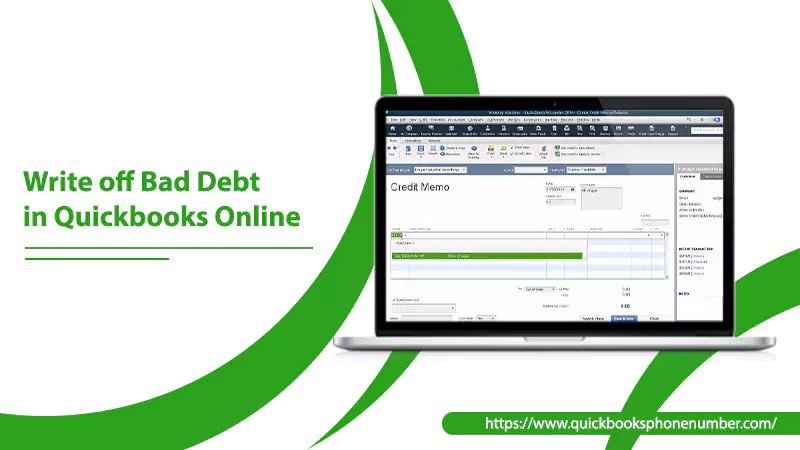
A Client or Customer Is Owing A Certain Amount Of Money And Not Paying In Due Respect Defines A Bad Debt! Indeed Bad Debts Are Really Bad! Not only does it give a painful experience to money lenders, but managing bad debts in records is equally difficult. It is an irrecoverable amount from the debtor. Learn how to write off bad debt in Quickbooks.
Bad debt is not recoverable as the money you have lent couldn’t return because of some uncontrollable circumstances. It is a business loss and should go on the profile side of the debt statement.
The money you owe is an asset for business, and if you can’t write off the bad debts, it’ll keep on inflating. Writing off bad debts in Quickbooks Desktop is different from the online version.
How Does Writing Off Bad Debts In QuickBooks Help?
Debts that are not collectible in Quickbooks are treated as bad debt and are written off. It ensures that the account receivables and net income are properly updated.
Bad debts act as a major hurdle when it comes to reconciling specific accounts and running precise reports. Recording a bad debt requires the account holder to monitor such transactions. When you do it, discounts and credit options in Quickbooks record the debt while the debt is organized in a different register to manage taxes.
You Might Also Like- How To Download QuickBooks In 2022?
Why Do You Need to Write off Bad Debt in QuickBooks?
Bad debts create real-time challenges as they can badly impact the profit and loss report badly during the reconciliation of QuickBooks.
It is quite important to write off bad debt in QuickBooks and keep discrepancies aside from the profit and loss income statement, especially when a business makes sales on credit.
When you write off bad debts in Quickbooks, the invoices could be cleared, which helps to acquire the net profit amount in Quickbooks.
Methods to Bad Debt In Quickbooks
Managing QuickBooks bad debts gets easier if you follow some steps. The primary step to managing bad debts in QuickBooks Desktop and Online—– is to understand the Account Receivable Aging Detail Report.
This report identifies which debts are going bad and what you need to write off. The next steps you need to follow are different for both QuickBooks Desktop and Online versions.
A new account is required to be created to write off bad debts in QuickBooks Desktop.
It should be an expense account to manage all the bad debts that occur in business.
Following are the vital steps that users can do in order to write off their bad debts using QuickBooks desktop with zero hassles:
Step 1: Inspect the Account Receivable Aging Report
- Go to the Reports section, visible on the left-hand side panel of the account
- Check the Account Receivable report from the particular search bar showing on top
- Now check the outstanding receivable account, click on the Accounts Receivable Aging detail Report
Step 2: Set Up The Bad Debt Accounts In QuickBooks
- Select the Gear icon visible on the Company section and select the Chart of Accounts option.
- Freeze the option to make a new account.
- Choose the Expense option from the particular Account Type drop-down section.
- Select your Bad Debts from the Detail Type drop-down list and enter the Bad Debt in the specific name
- Finish the procedure by Save and Close
Step 3: Set Up A Bad Debt Item
- Again, Select the Gear icon and choose Product and Services in the list section
- Go to the Information section and select the Non-inventory option
- Add the Bad Debt type in the Name Text box
- Choose the Bad Debt expenditure in the Income Account section
- Unmark the Taxable Check Box
- Select the Save and Close option
Step 4: Create a Credit Memo for the Bad Debt
- Select the plus icon, visible on the top of the QuickBooks dashboard.
- Choose the Credit Memo in the customer’s section.
- Go to the Customer drop-down list and select customer
- Select the items for a particular bad debt Product/Service field.
- Go to the memo text box and enter the bad debt amount
- Select the Save and Close option to finish the steps.
Step 5: Execute the Credit Memo to bid for Credit
- Select the plus icon visible on the top screen of the window and go to “Receive Payment” from the customer’s section.
- Select customer from the specific customer drop-down list
- Choose the invoice you want to write off from the respective Outstanding Transaction menu
- Choose the prepared credit memo from the specific credits section
- Run a check and ensure zero dollar amount
- Finally, Save and Close, and finish the procedure
Writing off bad debt in Quickbook is essential to clearing off records. By going through the steps, you have a bright chance to overcome and write off Quickbooks bad debts.
To make a striking difference, Quickbooks software helps to write off bad debts in the simplest manner.
The above-mentioned steps could be an excellent guide when it comes to evaluating, preparing,setting up and employing your debt data.
How to see a bad debt when you’re done setting up a bad debt account in Quickbook?
When you’re done with setting up the bad debt account in Quickbooks, this will provide a smooth time to run the report and view unpaid invoices while keeping a watch on unpaid invoices along with bad debts.
Can You Write Off bad Debt In Business?
Yes, if you prefer the accrual accounting method, it is possible to write off Quickbooks bad debts in some capacity as a form of deduction.
Hopefully, now managing bad debts in QuickBooks will no longer create problems for you. You can also call our QuickBooks support number to get an instant solution and learn about possible errors of QuickBooks online.